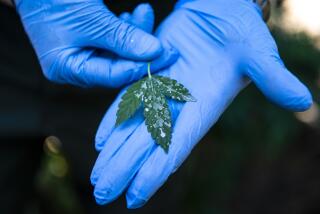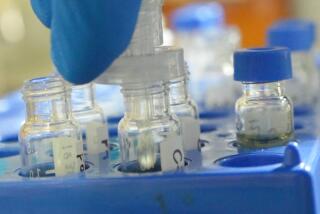Landis case succeeds in exposing faults
It could be weeks before an arbitration panel reveals whether American cyclist Floyd Landis has a chance to retain his Tour de France title in the face of doping allegations, but one thing was clear even before marathon public hearings ended last week: Landis succeeded in putting the international anti-doping enforcement system on trial.
The open proceedings raised very public questions about the competency and test procedures of the Paris lab that ruled Landis’ urine samples positive for illicit levels of testosterone. But they also exposed a rigid anti-doping enforcement system that could conceal lab errors and mistakes.
One of the arbitrators bluntly questioned World Anti-Doping Agency rules, suggesting that WADA’s labs shared a code of omerta rather than a code of ethics.
Earlier, a copy of the agency’s bylaws had been beamed to a large screen in the Pepperdine University hearing room. One clause notably forbade officials at all 34 WADA labs around the world from giving testimony to assist accused athletes or dispute the work of any other WADA lab.
“You’ve got a code of ethics that essentially states [the labs] can’t point out mistakes,” said Christopher L. Campbell, the arbitrator who had been selected for the panel by Landis.
“I think it’s a real problem.”
The restrictive clause was previously disclosed in “Presumed Guilty,” a series of reports by The Times in December that found the doping enforcement system favored accusers over athletes. It also found the WADA program to be based on flawed science, afflicted by faulty and inconsistent lab procedures and resistant to outside scrutiny.
The cyclist’s defense focused on many of the same issues. His attorneys painted, brushstroke by brushstroke, the picture of a forensic system with procedural and documentation standards far short of “beyond a reasonable doubt.”
Landis forced the hearings to be held in public, providing a uniquely open forum that also has raised the political stakes in the case.
The reputation of the Paris lab, one of WADA’s busiest, was pummeled by critical testimony from eminent scientists and admissions of mistakes by its own staff.
The potential effect of even minor mistakes in lab practice came into focus when hearing evidence showed that the case against Landis ultimately hinges on a single number -- minus 6.
As explained by experts in the case, testosterone breaks down in the body into four compounds, known as metabolites, which can be identified and measured in a urine sample. An anti-doping lab subjects these molecules to various analytical procedures to generate a so-called “delta-delta” value for each.
Under WADA rules, an athlete can be judged guilty if this value drops below minus 3 for any metabolite. Landis’ delta-delta value for the metabolite 5-alpha-androstanediol (5A for short) was minus 6.
Landis’ task at the hearing was to cast doubt on that figure. Lawyers for the U.S. Anti-Doping Agency, prosecuting the doping case against him, sought to protect its credibility.
USADA’s basic argument was that Landis’ number was so unnatural -- one of the lowest ever encountered -- that no concatenation of laboratory errors could have produced it from an innocent urine sample.
No matter how many retests the lab performed before expert witnesses, that figure always held up, observed USADA attorney Richard Young, adding that it was sufficient evidence all by itself.
“My opinion is that doping was going on,” testified Don H. Catlin, the recently retired head of the WADA anti-doping lab at UCLA. “It’s just inescapable.”
Raising doubts about the 5A result, the defense argued that in the context of Landis’ entire urinalysis profile, the figure looked more like a laboratory error than a credible analytical finding.
Defense witness John Amory, an expert in testosterone medicine at the University of Washington, pointed out that the 5A value always tracks closely the value of another metabolite, known by the shorthand 5B. No published study -- either of those not testing positive for doping or known dopers, including two published by expert witnesses who appeared for USADA at the hearing -- have ever found them to be more than two units apart, he observed. In Landis’ results, the gap was four.
“That doesn’t look like anything we’ve seen in studies of men who’ve been given testosterone,” Amory said.
That led to the issue of whether the Paris lab was capable of analyzing Landis’ urine with any accuracy whatsoever. Defense exhibits and testimony established that an enormous amount of the lab’s analysis involved subjective judgments by technicians -- so much so that when asked to rerun their tests, the technicians were unable to duplicate their original results.
Despite the disparities, USADA argued, the subsequent analyses still established that Landis was guilty.
Among the flaws Landis identified in the lab’s procedures was that it failed to calibrate its instruments properly, reducing its results to mere guesswork -- possibly skewed by a desire to find the results it was looking for. Christiane Ayotte, the director of WADA’s Montreal lab, who had characterized the lab’s errors as mere “boo-boos” that shouldn’t invalidate its findings, acknowledged under cross-examination that in one analysis of a Landis sample, the lab actually had identified a compound that wasn’t there.
“What is it?” Landis attorney Howard Jacobs asked as the witness frowned at an errant analysis page.
“No clue,” she replied.
Wolfram Meier-Augenstein, an expert on the analytical process used by the Paris lab, LNDD, testified for the defense that such sloppy work placed in doubt any number the lab produced, especially one as extreme as the 5A result.
“How do you know you don’t have spurious results?” he asked. “If I was running this lab, before I was on the phone to say this guy’s positive, I would rerun the tests to make sure the results stand up.”
Under cross-examination by Landis’ attorneys, Catlin and Ayotte acknowledged, if begrudgingly, significant flaws in the work of WADA’s Paris lab.
Landis’ own witnesses, predictably, were even harsher, pinpointing myriad disparities between the Paris lab’s procedures and those of forensic labs whose results have to stand up to the scrutiny of a civil or criminal court.
If Landis prevails with the arbitration panel, the outcome would almost certainly be seen as a blow to the reputation and credibility of the French lab. It could also raise doubts about other LNDD cases.
But Landis still faces an uphill battle for exoneration. WADA rules require arbitrators to treat the lab results as accurate unless they find proof of significant departures from international standards. The WADA code defines the standard of proof necessary for a finding of guilt to be simply the “comfortable satisfaction” of the arbitrators.
With few exceptions, arbitrators in previous cases have dismissed allegations of poor lab procedures as immaterial to the final results.
Unlike any previous cases, however, this panel of arbitrators is conducting its deliberations under a spotlight of public attention.
They also will be drafting their ruling amid a highly charged atmosphere over fresh public disclosures of doping in cycling. In the last week, three leading European cyclists confessed to doping with EPO, a blood hormone, during the 1990s. Although that period predates Landis’ rise to prominence, the confessions underscore cycling’s reputation as a drug-ridden sport -- a point USADA attorneys made repeatedly during the hearing.
USADA also departed from scientific argument in the Landis case to take advantage of another development during the nine-day hearing -- the appearance of former Tour de France champion Greg LeMond, testifying for the prosecution. LeMond’s appearance was widely judged to be a debacle for Landis, largely because his then-business manager was revealed to have made a salacious, anonymous call to LeMond, supposedly to deter him from testifying.
But the incident also could be viewed as a problem for USADA. On one level, it showed the willingness of the agency, which maintained throughout the hearing that its accusation was based strictly on scientific evidence, to impugn an athlete’s character with testimony that was unsubstantiated and scientifically irrelevant.
LeMond testified that Landis had implicitly confessed to him, in a phone conversation shortly after the doping charge was made public. He drew this conclusion when Landis, after hearing LeMond urge him to “come clean,” replied simply, “What good would that do?” But Landis testified that he had explicitly denied the doping charge to LeMond.
When Landis attorney Jacobs attempted to cross-examine LeMond, the cyclist’s lawyer intervened. He instructed LeMond not to answer, while acknowledging he had no legal grounds to do so.
Jacobs erupted. “This is completely unfair.”
The arbitrators unanimously rejected Jacobs’ motion to strike LeMond’s testimony, although they offered no indication of how much weight they ultimately would give it. Arbitrator Richard McLaren, who was appointed to the panel by USADA, did speak up for the process, however.
“Mr. Jacobs,” he said in one of his rare comments during the hearing, “we don’t accept your proposition that the proceeding is unfair.”
*
(BEGIN TEXT OF INFOBOX)
A Landis timeline
Significant events in the doping investigation involving cyclist Floyd Landis:
2006
* July 23: Landis becomes the third American rider to win the Tour de France.
* July 27: The International Cycling Union announces an unidentified Tour de France rider has tested positive for a performance-enhancing substance. Landis team, Phonak, confirms later that day that Landis’ “A” sample tested positive for abnormal testosterone levels.
* July 31: Anonymous source tells the New York Times that Landis’ urine sample showed the presence of synthetic testosterone.
* Aug. 5: Landis’ “B” sample confirms the “A” result. Team Phonak fires Landis. Tour de France officials say Landis is no longer considered the 2006 champion, although the title can’t be officially stripped until the hearing process is complete.
* December: USADA requests permission to test Landis’ seven “B” urine backup samples from the Tour de France that were not originally tested because the corresponding “A” samples were negative.
2007
* February: Landis’ defense team contends that the same two technicians at the French lab were involved in testing his “A” and “B” samples, a protocol violation that resulted in the dismissal of a case against another cyclist.
* April: The arbitration panel rules in a 2-1 vote that Landis’ leftover “B” samples can be tested at the French lab and possibly used as evidence in the case, although they cannot be considered official positives.
* May: The U.S. Anti-Doping Agency presented its case against Landis. It could be a month or more before the three arbitrators, who sat through nine days of testimony, sort through all the evidence and issue their decision.
--
Los Angeles Times
More to Read
Go beyond the scoreboard
Get the latest on L.A.'s teams in the daily Sports Report newsletter.
You may occasionally receive promotional content from the Los Angeles Times.










